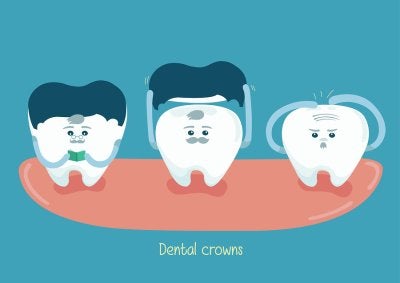-
Teeth vs. Food: The Good and the Bad [INFOGRAPHIC]
Everyone wants to have a beautiful smile full of healthy, white teeth. Depending on what you’re eating, however, you could be doing your teeth a disservice. Certain foods are better for your mouth than others, as your dentist near Bel Air will tell you. You probably know that both hard and chewy candies contain a lot of sugar, which can lead to tooth decay. You may be surprised to find out that even certain fruits are less than ideal for your teeth because they contain high levels of acid. Foods such as low-fat cheese, apples, and crunchy carrots are all mouth-healthy choices. Check out this infographic from Your Smile to learn more about what foods to eat and what to avoid for the health of your teeth and gums. Please share with your friends and family!

-
What Is Orthodontics?
When you meet with your orthodontist in Bel Air , his or her primary concern will have to do with the way your teeth and facial muscles interact with each other. Orthodontics can be used in combination with cosmetic dentistry to achieve an attractive and efficiently functioning smile. Watch this video clip to find out more about orthodontics.
Just like your dentist, your orthodontist will conduct a mouth exam in order to take a detailed look at your teeth and gums. Depending on what he or she finds, a treatment plan may be devised. This mouth exam allows your orthodontist to find out if your teeth are growing in evenly as well as their proper placement. Braces, wires, and headgear are common orthodontic treatments that are used to correct misaligned teeth and yield proper bites. More and more adults are using braces and other orthodontic procedures due their newly discreet nature.
-
Improving Your Smile with Veneers
If you long for the days when your smile was bright, full, and gapless, you may be interested in learning about veneers in Bel Air. This type of treatment can improve your smile in a number of ways. Many individuals enjoy the relatively noninvasive nature of veneer treatment; unlike other dental procedures that treat similar problems, veneer application is not an invasive surgical procedure. Continue reading if you are interested in finding out how you can improve your smile with veneers.
Why Choose Veneers?
Veneers may be an excellent choice if you suffer from cracked, damaged, or discolored teeth. Your dentist can cover your diminished teeth with veneers to protect them from further damage and revitalize your smile. This will provide you with a newfound sense of confidence and a reason to smile. Veneer treatment can resolve problems stemming from gaps in your teeth, and it can even improve your bite in some cases. If you are a coffee drinker or a cigarette smoker and your discolored teeth resist teeth whitening treatments, veneers can make for a suitable alternative . In the event that you are having just one or two veneers placed, your dentist can match the shade of your veneers to the color of your natural teeth.
gaps in your teeth, and it can even improve your bite in some cases. If you are a coffee drinker or a cigarette smoker and your discolored teeth resist teeth whitening treatments, veneers can make for a suitable alternative . In the event that you are having just one or two veneers placed, your dentist can match the shade of your veneers to the color of your natural teeth. What Is the Procedure Like?
Visit your dentist if you think veneers might be right for you. If your dentist agrees, he or she will remove a small amount of enamel from the teeth that will receive veneers; this is done so that the veneers fit in with your teeth rather than protrude from your mouth. The natural tooth will be coated with a special resin, and your dentist will use a curing light to bond the veneer to your tooth. You can then begin to enjoy your new smile immediately by showing it off on your way out of the dentist’s office.What Are “No Prep” Veneers?
Your dentist may be able to apply a veneer without removing much enamel from your tooth. This treatment is even less invasive and can be done more quickly, but not everyone is eligible for the procedure. -
Spotting the Signs of Gingivitis
Failing to take care of your teeth properly and see your dentist in Bel Air on a regular basis can result in problems such as gingivitis. If left untreated, this condition may progress into periodontal disease and can result in tooth loss. It is helpful to familiarize yourself with the various signs and risk factors associated with gingivitis. Continue on if you could use some help spotting the signs of gingivitis.
The symptoms of gum disease are not always obvious, which makes the condition difficult to detect in some cases. One of the most prevalent red flags is the presence of blood when you brush your teeth. If you notice that your gums are bleeding, it is wise to schedule an appointment with your dentist in the near future. Your gums may also be swollen and tender to the touch. Another sign of gingivitis is shifting of your teeth or change in your bite. If you feel like your teeth do not fit together the way they usually do, visit your dentist to find out if you have gingivitis. Individuals who use tobacco products, practice poor dental hygiene, or have certain illnesses should be particularly wary regarding these signs.

-
The Dental Patient’s Guide to Crowns
It is important to set up a consultation with your dentist in Bel Air in order to determine what kind of dental treatment is best for your needs. However, it is also helpful to learn about the various types of procedures beforehand so that you can get an idea of what to expect. Dental crowns are used to treat many dental issues including weak or broken teeth, tooth decay, and missing teeth when used with dental implants. Read on for the dental patient’s guide to crowns.
Preparation and Procedure
If you and your dentist have decided that a dental crown is the optimal treatment for your situation, you will make two appointments. The first appointment presents your dentist with the opportunity to examine your teeth, gums, and jawbone. He or she may determine that a root canal treatment is necessary before going through with the dental crown procedure. After anesthetizing the tooth and gum tissue, your dentist will file down your tooth so that there is room for the crown to sit properly. He or she will then send an impression of your tooth to a lab, and a crown will arrive in two to three weeks . During the second appointment, your dentist will double check the permanent crown and then cement it.
appointments. The first appointment presents your dentist with the opportunity to examine your teeth, gums, and jawbone. He or she may determine that a root canal treatment is necessary before going through with the dental crown procedure. After anesthetizing the tooth and gum tissue, your dentist will file down your tooth so that there is room for the crown to sit properly. He or she will then send an impression of your tooth to a lab, and a crown will arrive in two to three weeks . During the second appointment, your dentist will double check the permanent crown and then cement it. Types of Crowns
Dental crowns are incredibly versatile in that there are many different types to choose from. Metal crowns tend to be among the most durable, and they typically require less removal of tooth structure. Ceramic and porcelain crowns, on the other hand, can be made to match your natural tooth color but tend to wear down over time. Dental crowns made completely of resin are most affordable, but they may also be most susceptible to cracking.Maintenance and Working Life
A dental crown can be an excellent restoration that improves the aesthetic appeal and function of your tooth, but it is important to care for them. Brush your teeth twice each day and floss once per day, and be sure to visit your dentist on a regular basis. Properly cared for crowns can last for up to fifteen years.
RECENT POSTS
categories
- Uncategorized
- General Dentistry
- Toothache
- Emergency Dentistry
- Family Dentistry
- Receding Gums
- Cosmetic Dentistry
- Veneers
- Gum Disease
- Gingivitis
- Dental Crowns
- Orthodontics
- Dental Implants
- Root Canal
- Wisdom Teeth
- Teeth Whitening
- Your Smile
- Composite Fillings
- Lumineers
- Dentures
- Invisalign
- BrightSmile
- Dental Bridge
- Abscessed Tooth
- Sealants
